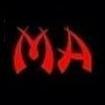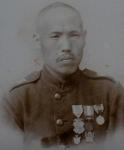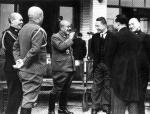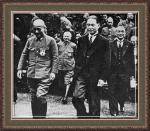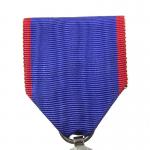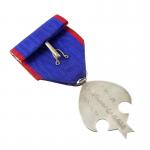Well, as far as I understand both badges were issued by this (slightly mysterious ) Imperial Army Dog Association.
Looks like on the right we have special award from Tokyo branch of organization and on the left is one of these "participation badges".
Military awards?
Hmmm...
More like military related
Anyway, here comes very interesting info from Elmer Veldkamp (Department of Cultural Anthropology, University of Tokyo) working paper "Animal monuments and memorials in pre-war Japan and postwar developments: on the treatment of monuments for the human and animal war dead" presented at Yale University on March 26, 2008 (full text is available online here http://todai-yale.jp/resources/docs/Mr.VeldkampEn.pdf)
Compared to war horses, the history of war dogs is more recent, but the experimental stage
overlaps with that of carrier pigeons. It is said that the initial steps that lead to the utilization
of dogs in the Imperial Army were taken by police lieutenant Hagiwara Takuji of the
Shibaguchi police office around 1912-1913, when he began gathering information and
knowledge about dog training and conducted training experiments near his house in Nakano.
In 1916, the dogs were transferred to the Ueno police station to help fight crime in central
parts of the city. In 1920 the project was discontinued due to economical difficulties, but the
experience and knowledge about dog training that had been obtained was to play a role in the
raising of war dogs later on as well (Imagawa 1996).
The utilization of war dogs in Germany and Belgium during WorldWar I was observed with
great interest, and in 1919 a war dog section was established at the Imperial Army's Infantry
School (rikugun hoheigakkō) in Chiba, effectively starting research and education concerning
the raising and training of war dogs. From this time on, books concerning the training of dogs
start to be published, and the conclusion is drawn that rather than Japanese dog breeds, the
foreign breeds (especially German Shepherds) were considered to be suitable for military use.
From the 1920s onward war dog breeding starts to spread over the country. In 1928 the South
Manchurian Railway Company (SMRC) employed sentry dogs to secure its mines, and from
the 1930s the breeding and management of military animals expands over the national
borders to the colonies of Manchuria and the Korean peninsula as well. The Dictionary of
National Defense (Kokubō Daijiten) states that we may say this is still an experimental
phase. In due time, this will probably develop into a War Dog Squad (gunyōkentai), and
acknowledgement of the developmental character of war dogs in Japan is flanked by
expressions of their splendidness (subarashisa) at the same time. Moreover, some in the
Army suggest that investigation be put into the actual number of German shepherds in Japan
and that they be trained for mobilization with the eye on future times of war. In the 1930s
the results of these training experiments are put to practice, and the use of war dogs takes off
in earnest.
3. THE GOLDEN AGE OF WAR DOGS: FROM THE MUKDEN INCIDENT ONWARD
The Mukden Incident (Manshū Jihen) of September 18, 1931, became an opportunity for
war dog fever to really take off. In Manchuria breeding and raising war dogs had already
taken on mature proportions, and stories of their achievements in the various battles
broadened recognition and estimation of war dogs on the Japanese mainland as well. At that
time, the Japan Shepherd Club (established in 1928), a civilian gathering of dog-lovers
already existed, but in 1932 the Imperial War Dog Association (Teikoku Gunyōken Kyōkai)
was established, which had the purpose to promote development of war dogs.
In the same year the war dog association was established, the Association for Preservation
of Japanese Dogs (Nihonken Hozonkai) came into being, and as we will see later in this paper,
the stories of Nachi and Kongō (two war dogs that died in the Mukden Incident) and of the
loyal dog (chūken) Hachikō decorated the newspaper pages. These occurrences indicated a
growing interest among the general public for both dogs as pets and military dogs.
The sudden surge in demand for war dogs following the Mukden Incident could not be met
by the war dog breeding stations (gunyōken ikuseisho) alone, and the army commenced the
purchase of civilian dogs and began to accept dogs donated by War Dog Association members.
Cover pages of the associations journal Gunyōken (1932-1944) of the latter half of the 1930s
are covered with slogans such as One member per household! One dog per household!
(Kogoto ni kaiin! Kogoto ni gunken!; issue 7-9), One household, one dog Service to the army
and the country! (Ikko ikken Gunkoku hōshi!, issue 7-10), Start by keeping a dog enter
the War Dog Association (Mazu kae gunken haireyo teiken ,issue 8-3), illustrating the
atmosphere at that time clearly.
:cheers:



